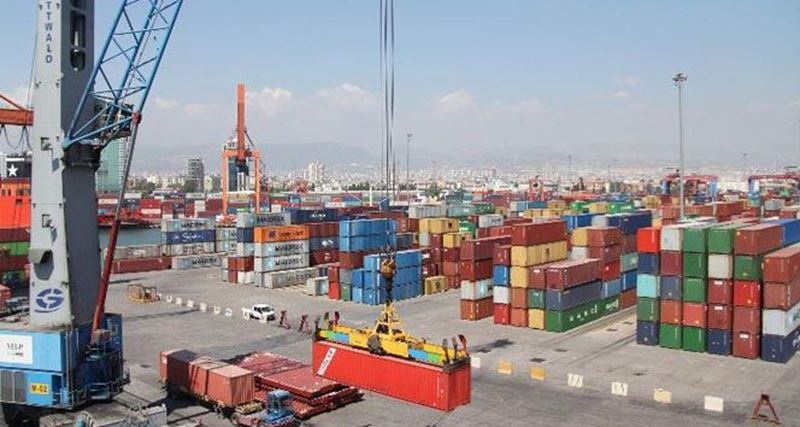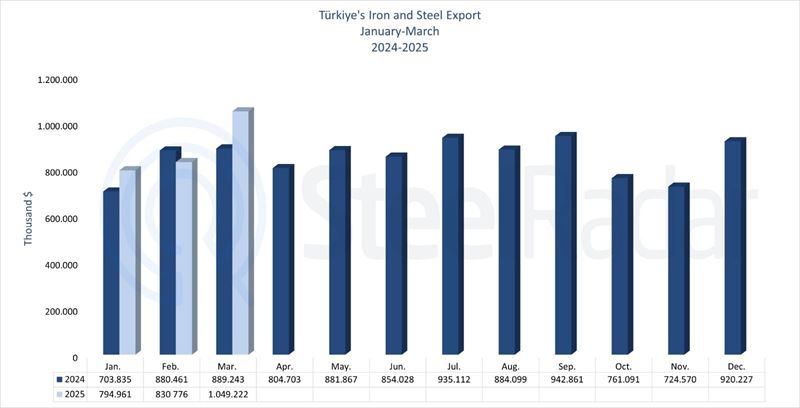However, the foreign trade balance reversed in the first quarter of the year. During the January-March period, the foreign trade deficit increased by 11% compared to the same period last year, from USD 20 billion 255 million to USD 22 billion 488 million. In this period, the ratio of exports to imports decreased from 75.9% to 74.4%.
Exports and imports increased
According to provisional data released within the scope of the general trade system in cooperation with the Turkish Statistical Institute (TÜİK) and the Ministry of Commerce, exports increased by 3.4% in March 2025 to USD 23 billion 415 million, while imports increased by 2.2% to USD 30 billion 610 million.
During the January-March period, exports increased by 2.5 % to USD 65 billion 323 million and imports increased by 4.5 % to USD 87 billion 811 million.
Foreign trade deficit excluding energy and gold was USD 1.6 billion
Excluding energy products and non-monetary gold, exports increased by 3.3% to USD 21 billion 516 million and imports increased by 1.4% to USD 23 billion 153 million in March. Thus, foreign trade deficit excluding energy and gold was recorded as USD 1 billion 637 million. In the same month, foreign trade volume increased by 2.3% to USD 44 billion 670 million, while the ratio of exports to imports was 92.9%.
Most exports to Germany, imports from China
In March, the country to which Türkiye exported the most was Germany with USD 1 billion 858 million, followed by the United Kingdom (USD 1.5 billion), the USA (USD 1.4 billion), Italy (USD 1.2 billion) and France (USD 974 million). These five countries accounted for 29.9% of total exports.
China ranked first in imports with USD 4 billion 6 million. Russia ( USD 3.3 billion), Germany (USD 2.5 billion), France (USD 1.5 billion) and Italy (USD 1.5 billion) followed. The share of these five countries in total imports was 41.8%.
During the January-March period, Germany ranked first in exports with USD 5.3 billion. In the same period, China became Türkiye's largest import partner with USD 11.6 billion.
The share of manufacturing industry in exports is 94%
In March, according to economic activities, the share of manufacturing industry in exports was 94%, the share of agriculture, forestry and fishing was 3.7%, and the share of mining and quarrying was 1.7%. In the January-March period, these rates were 93.7%, 4.2% and 1.5%, respectively.
Share of intermediate goods in imports stood out
In March, 68.1 % of imports were composed of intermediate goods, 14.7 % of capital goods and 17 % of consumption goods. In the first quarter, the share of intermediate goods in imports increased to 71.2%.
The share of high-tech products in exports was 4.5 %.
In March, according to ISIC Rev.4 classification, the share of manufacturing industry products in total exports was 94%, while the share of high-tech products in this group was recorded as 4.5%. In the same period, the share of manufacturing industry products in imports was 78.7% and the share of high-tech products in this item was 12.8%.
During the January-March period, the share of high-tech products in exports and imports was 3.6% and 11.8%, respectively.
Increase in seasonally adjusted data
According to the seasonally and calendar adjusted series; In March 2025, exports increased by 5.5 % and imports by 3.5 % compared to the previous month. In the calendar adjusted series, exports increased by 6.9% and imports by 5.9% compared to the same month of the previous year.
Foreign trade deficit widened according to the special trade system
According to the private trade system, in March 2025, exports increased by 3.4% to USD 21 billion 355 million and imports increased by 4.2% to USD 29 billion 202 million. In this context, foreign trade deficit increased by 6.5 % to USD 7 billion 847 million in March. The ratio of exports to imports decreased to 73.1%.
During the January-March period, according to the private trade system, exports increased by 2.9% to USD 59 billion 466 million and imports increased by 4.7% to USD 82 billion 873 million. Thus, while the three-month foreign trade deficit was USD 23 billion 406 million, the ratio of exports to imports decreased to 71.8%.











Comments
No comment yet.